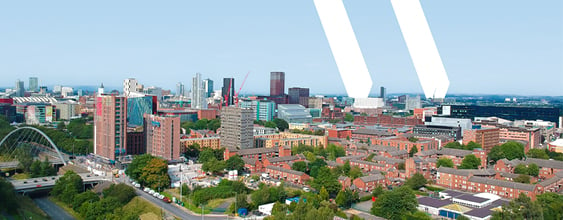In recent years, vertical transportation strategies have been designed to minimize energy use. For example, newer elevators are fitted with much more sophisticated electronic load weighing devices, which measure the strain on certain components in order to apply the minimum amount of torque to the motor to move the weight in the car. The other area of efficiency is in the management of passengers. With hall call allocation control, for example, you present your swipe card at the lobby entry speed gate or elevator control system. It knows where you need to go to, summons an elevator and tells you which one to board. The advantage is that this is completely touch-free, but the problem is that the efficiency works directly against social distancing. Hall call allocation clusters people who are going to the same floor or sequential floors, so that the car only makes a limited number of stops with a greater number of people inside. That has two effects: it makes the cars busier and it means that people cluster around a specific entrance in the lobby, both of which work counter to social distancing. WSP’s VT team is working with elevator suppliers’ R&D teams to explore options for reducing the sensitivity and efficiency of these control systems, to allow the elevators to be dispatched containing fewer passengers.
Can elevator manufacturers detune or desensitize the control systems or reset the load weighing devices?
At the moment, we don’t know how easy it is to do that. Offices that use these complex controls may need to introduce a temporary concierge stationed before the speed gate or turnstiles to restrict the flow of people into the elevator lobby, to help manage crowding during times of high demand. Each tenant in the building can control the lobby on their level, but it will still be crucial to address the underlying algorithm technology, to make sure that the elevator isn’t stopping and allowing more people into the car.
Post-pandemic, people may remain reluctant to interact with elevators.
With advances in smart building and smartphone technology, there are already solutions that reduce the need to touch the controls. For example, sensors in residential buildings can enable the system to understand when a resident appears to be approaching and send an elevator to that level.
Technology coming on to the market could almost remove the need to touch anything at all.
In smart buildings, building users might wear keyrings or fobs integrated to the security system that would enable their movements to be tracked. Sensors in lobbies would detect that you’ve turned left towards the elevators and start preparing a car for you. Many security systems now support virtual fobs, by interacting with your phone or smart device. They could potentially go one step further, allowing employers to schedule arrival time elevator access to spread out peak demand. This strategy may ultimately be the best for larger commercial tenants occupying multiple floors, who have greater control over the occupancy of elevator cabs. The bigger question is whether people really want their phone to be controlling their lives to that degree. Do you want to be mapped by your mobile phone signal and for your phone to exchange that information with the building? That’s a whole different debate.
Stairs may become a more prominent consideration in buildings.
They are more open by definition, and there is better visibility, which makes social distancing easier. Stairs also support wellbeing strategies by encouraging people to move more. But there are only so many flights we can expect people to walk up. Industry standards recognize that if people work on the first floor of a building, 90% of them will walk up. On the second floor, that drops to 50%, and the third 25%. Above that, it’s elevator-only traffic. For tenants taking multiple levels in commercial buildings, convenient access stairs should be encouraged within their individual domain. As with elevator buttons, handrails are likely to become high-traffic touch points so they will require enhanced cleaning, as well as hand sanitizer dispensers at entry and exit points.
In the longer term, it’s unlikely we will be designing buildings to allow 20m2 per person to accommodate social distancing.
For a building to make commercial sense, the rental stream has to support the business case, so it has to have a reasonable population. To make a large building practical, the total area of elevator cores has to be as small as possible and it’s always a fine balance between space-take and elevator performance. In very large buildings, we already use double-deck elevators to increase capacity without taking up extra space, as well as algorithm-based controls to manage it efficiently. The shape and size of buildings may change, but the population will still have to be fairly high in order for them to make financial sense. The crucial consideration will be the amount of space that has to be allocated to a person within the building and how much space will be acceptable for a person travelling in an elevator car. This might mean that future buildings are designed to accommodate fewer people in the same size footprint, with larger elevator cars to provide increased personal space.














